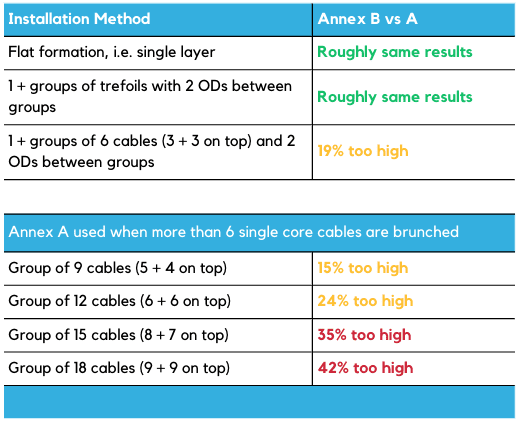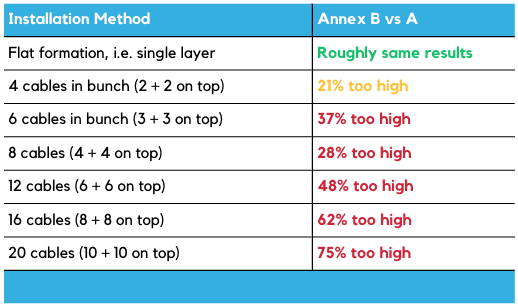28 November 2024
How to calculate the current rating to prevent cable overheating

Get in line with a Class approved methodology to correctly calculate the current rating (ampacity) in order to prevent cable overheating.
Table of Contents
Cable Overheating
In modern ship design, electric propulsion and large consumers with continuous operation commonly increase the risk of cable overheating. For example, when numerous cables are bunched together without sufficient air circulation for cooling. Hence, this article is set to provide a way to correctly calculate the current rating (ampacity).
Current Rating Requirements
DNV Rules for classification, Part 4, Chapter 8, and the offshore standard DNV-OS-D201 set the requirements for the determination of cable current-carrying capacity (ampacity) on DNV-classed vessels. Electrical rules contain tables for ampacities together with derating factors collected from IEC 60092-352 (2005). The standard describes two alternative ampacity calculations in Annex B and Annex A.
Annex B: General installations
Ampacity tables in the DNV Rules are based on Annex B. Initially established in 1958 and based on limited experimental data, IEC 60092-352 Annex B gives tabulated ampacities for general installations. It consists of one table, whereby the designer selects the size of the cable conductor and whether it is a single-core, two-core or multi-core cable.
Up to six cables can be bunched together without derating. More than six cables grouped together require a de-rating factor of 0.85. Annex B is popular because it is simple to use. In many situations, this method for general installations gives acceptable results. As described in Annex B, the tables give only average values for the current ratings; these are not exactly applicable to all cable constructions and all installation conditions existing in practice.
Annex A: Defined installations
This calculation method has been derived from a technical basis established from experimental data on a number of cables and installation details. It includes six different installation methods and three correction tables. Due to the detailed input for installation methods, Annex A calculations are considered the more accurate of the two methods A and B. According to DNV Rules, Annex A shall be used in the following two cases:
- If bunched cables are expected to be under full continuous load simultaneously with the risk of being overheated, then IEC 60092-352 Annex A should be used.
- When more than six single-core cables are bunched without spacing for air circulation around each cable, the correction factor shall be as given in IEC 60092-352 Annex A.
Overharmonic Currents
High levels of Total Harmonic Distortion (THD) can create additional heat losses which are not included in Annexes A and B. Due to the high frequencies of harmonics, the skin effect can further decrease the effective cable conductor area. Both issues necessitate increased cable conductor dimensions to avoid overheating of cables.
Maximum 2 Layers
Power cables under full continuous load should not be installed in more than two layers. This would prevent air circulation around the enclosed cables inside the bunch and make it impossible to evaluate cable temperatures during sea trials. An exemption is six multi-core cables installed in trefoil with two cable outer dimensions (ODs) between bunches.

Engine Room Fires – 3 Causes & Prevention Tips
DNV has published a piece of technical news, focusing on how to identify engine room fires and take preventive measures accordingly.
Ship Nerd
Comparison between Annex A and Annex B
Please be aware of cases where the average calculations of Annex B allow for higher ampacities than Annex A, which may lead to a higher risk of cables overheating. To reduce this risk, a detailed comparison is provided for various installation methods.
Comparison for single-core cables:

Comparison for multi-core cables:

Recommendations
Annex A shall be used if bunched power cables are expected to be under continuous full load simultaneously. Annex A shall also be used when more than six single-core cables are bunched without spacing for air circulation around each cable. It is more economical to split large cable bunches into smaller bunches surrounded by air to avoid any unnecessary derating of expensive cables. A guidance for the verification of cable temperatures during sea trials is included in the appendix.
Source: DNV
See Also
The 10th session of the IMO’s Sub-Committee on Ship Design and Construction (SDC 10) was held from 22 to 26 January 2024. To ensure the safety of the crew, draft amendments were agreed to the Load Line Protocol relating to the setting of guard rails on exposed deck structures. Draft goal-based requirements for electrical and machinery installations were agreed in general, while work to define goal-based requirements also for non-traditional steering and propulsion systems made good progress. SDC 10 also moved forward with the revision of the explanatory notes to the Safe Return to Port requirements for passenger ships.

IMO SDC 10: New Ship Design & Construction Guidelines
A quick and on-point recap of the 10th session of the IMO’s Sub-Committee on Ship Design and Construction (SDC 10) in January 2024.


